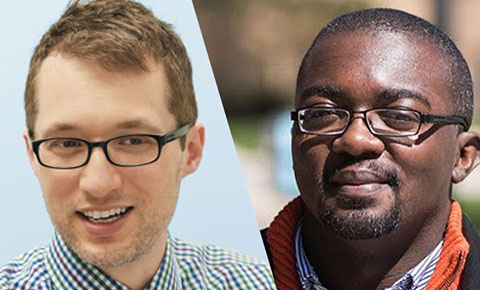News Literacy in an Era of Fake News

People are influenced by inaccurate information even when they know better -- and even when they’re warned, Northwestern University professor David Rapp said during a recent webinar on news media literacy.
“By influenced, I mean they repeat the inaccurate information, they’ll share it when answering questions, and they consider impossible things plausible,” said Rapp, who has been studying how people process information for more than two decades.
Rapp, professor of learning sciences in the School of Education and Social Policy, and Michael Spikes, a learning sciences doctoral student , were among several Northwestern experts offering research-backed guidance on finding useful and credible news stories during the webinar “Navigating Information in the Era of Digital News and Social Media,” an event held by Indivisible Evanston, a progressive, activist group.
Many of us are susceptible to misinformation because we don’t know it’s inaccurate in the first place, Rapp said. We also might want inaccurate information to be true. “Perhaps it connects with our identity, belief systems, family expectations, or cultural upbringing,” Rapp said. “People may also want it to be true. These things all influence what people convey to others.”
Rapp’s research suggests that people tend to believe information from sources they deem credible. If they don’t know the nature of the source, they may take content at face value and only later evaluate – and potentially discount – what they’ve heard.
Our willingness to consider false information also depends on whether we can retrieve it from memory without difficulty. If we can easily remember it, we’re more likely to believe it. “If someone continuously repeats an idea to you, then it’s easier to recall and you may believe it’s true. Similarly, if information is presented in a way that rhymes, we tend to think it’s more valuable,” Rapp said during the webinar.
Rapp and his team in the Reading Comprehension Lab have presented people with misconceptions related to health and then asked whether them the ideas are true. Participants who say they know the most end up endorsing the most misconceptions, Rapp said. “This phenomenon is similar to the Dunning–Kruger effect, which is the idea that people with less experience or ability related to a specific task often overestimate how well they’ll do it.”
Spikes, an expert in news media literacy education, training, and curriculum design, said that consumers face a variety of challenges when they’re reading or watching something, including overload and the ongoing tension between speed and accuracy.
“It takes time to get accurate info, but our information ecosystem prioritizes speed,” Spikes said. “The same thing happens to journalists. They want reliable info for their readers but there’s a push to get it out fast.”
In addition to Rapp and Spikes, the event also featured Stephanie Edgerly, associate professor at the Medill School of Journalism, Media, Integrated Marketing Communications; Rachel Davis Mersey, associate dean of research and professor at Medill; and Steven Franconeri, professor of psychology at Weinberg College or Arts and Sciences.
The panelists shared several tips on improving news literacy, including:
- Don’t share a fake news link, even if you are labeling it as misinformation, since sharing will fuel the algorithm. Instead, take a screenshot or photo.
- Think about what is important to you when you read a story. “If I see a headline or come across a story that might get me riled up, I ask myself about the context of what I need to know to understand,” Spikes said. “When I read a print story, I consider that context and that’s what important to me. It helps me understand what’s going on and goes well beyond the headline.”
- Evaluate what you read. We’re very quick to look for and read news that confirms our beliefs and move on. The big questions you should be asking are, ‘What are they telling me? How do they know? What don’t they know and why don’t they know it?
But ultimately, news literacy requires much more than advisory shortcuts or techniques or helpful tips to contemplate news reports, Spikes said. “It’s a way of thinking, doing, and being when you approach info. Ask yourself, what came before? What came after? And always consider the point of view of the person giving you the information.”